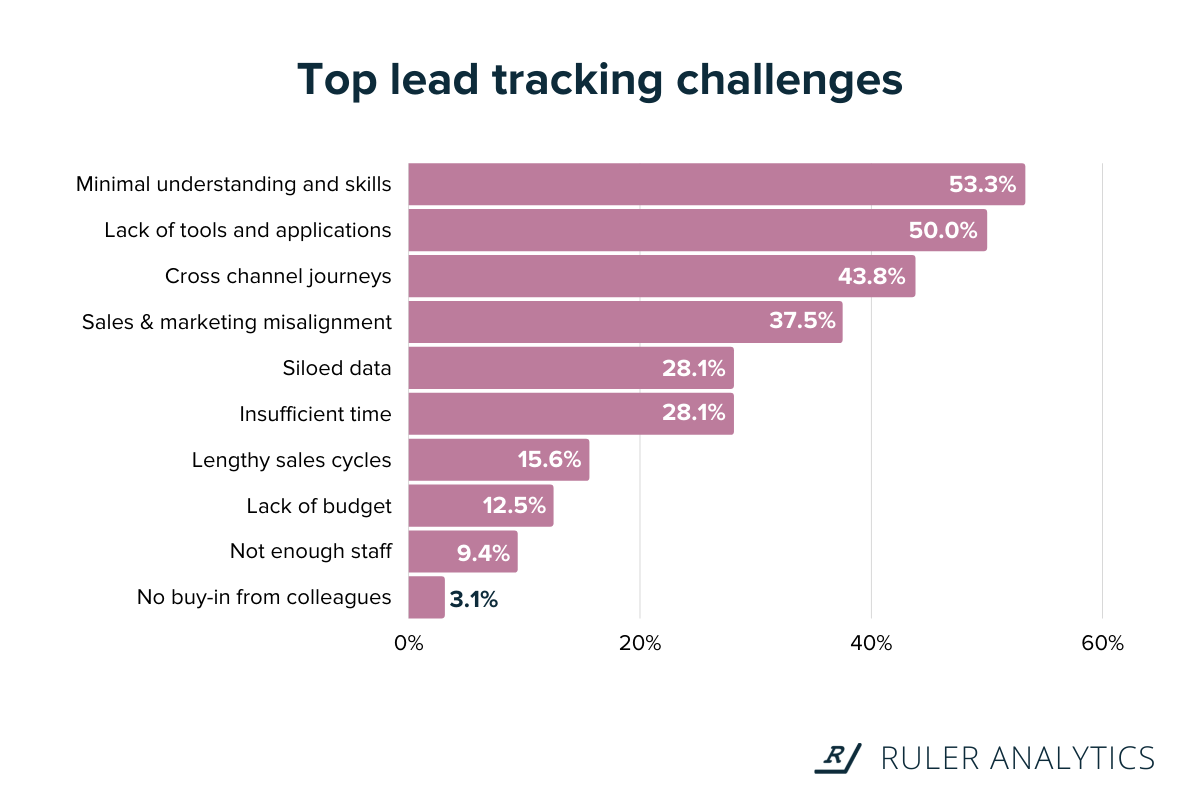Businesses that track leads can make informed decisions to improve lead quality and revenue. In this article, we take a closer look at the importance of lead tracking and share the best practices on how to get started.
Marketing teams have long focused on lead quantity as a key metric for growth, and who can blame them?
More leads equals more revenue, right?
Technically, no.
The truth is that not all leads are created equal.
Many marketing teams are making the mistake of handing over every lead to sales. They’ll take a step back and wait for sales to swoop in for the close.
Unfortunately, this is very rarely the case.
More often than not, sales will get overwhelmed with leads that aren’t pre-qualified and will accuse marketing of wasting their precious time and energy. Eventually, sales will become unenthusiastic and will stop following up with leads sent from marketing as they’ll view them as a lost cause.
Marketing, however, will complain that sales aren’t working hard enough to convert their leads into sales.
It’s complicated, but it really doesn’t have to be.
With lead tracking, there’s no more of marketing washing their hands at the handoff stage, and sales can no longer accuse the marketing of delivering low-quality leads. Instead, they’ll unite as one to focus on producing the right type of leads.
As a provider of lead tracking software, we asked sales and marketing experts to weigh in and share top tips on how to track leads and better determine the quality.
For this article, we’ll discuss:
Let’s get started!
Pro Tip 🚀
Are you struggling to drive high-quality leads for your business? You’re not alone. Get your complete guide to lead tracking and gain a single view of your lead generation activity, from the initial awareness to the point of acquisition. Or, view the cheatsheet to lead tracking here.
“From my experience, lead tracking helps brands identify whether all their lead generation paid off or not,” says Jonathan Saeidian, CEO & Co-Founder at Brenton Way.
Most people are already familiar with the concept of lead tracking, but for the sake of clarity, let’s quickly take a look at how it works. As the name suggests, lead tracking is the process that allows businesses to monitor lead activity along the path-to-purchase.
Effective lead tracking allows sales and marketing teams to seamlessly work together and take a collaborative approach to understand what constitutes a high-quality lead and how marketing impacts the sales cycle.
Shaun Heng, VP of Growth & Operations at CoinMarketCap, believes that it’s “essential to track leads efficiently to avoid wasting time and resources on dead ends.”
While lead tracking offers many benefits and opportunities, there are various roadblocks preventing teams from establishing a single view of leads and customers.

According to our research, respondents ranked “minimal understanding and skills (53.3%)”, “lack of tools and applications (50.0%) and “cross channel journeys (43.8%)” as the top three lead tracking challenges.
More than half of respondents agreed that a lack of skills and knowledge is the main barrier to successful lead tracking.
While it may seem straightforward, manually tracking leads from start to finish generally involves many moving parts. It requires a lot of skill, coordination and time that most sales and marketing teams don’t have.
If any of this feels somewhat familiar, don’t worry. We have plenty of expert tips and techniques to help you maximise your skill-set further down.
If we’ve learned anything as a provider of multi-touch attribution, it’s that lead tracking is extremely difficult, if not impossible, without the right tools at hand.
Our survey found that half of companies lack the right tools and applications to track leads throughout different stages of the customer journey.
Despite the availability of technology, many businesses still rely on manual input of lead data into their databases. Manual data entry is slow, inaccurate and extremely time-consuming.
That’s why lead tracking tools like Ruler Analytics are a buried treasure for businesses. They allow support, sales and marketing teams to track lead activity throughout each stage of the customer journey and determine which channels contribute the most qualified traffic and leads.
💡 Pro Tip
You might already know, but Ruler is a marketing attribution tool. Ruler tracks the customer journey, evidencing every step a visitor makes in their journey and matches revenue back to the source. We won’t go into too much detail here, as we have plenty of content on this already. In fact, our eBook on how Ruler works can provide you with everything you need to know and more.
Lead tracking has never been easy, and the increase in digital communication channels has made things even harder for marketers. According to Think with Google, users could have up to 20 touchpoints with your content before converting into a customer. And, during our own study, we found that nearly 20% of companies have sales cycles greater than four months.
So, what makes cross-channel journeys so difficult? Well, most marketers will use Google Analytics to track leads. Google Analytics does a great job of showing you the start and end of a visitor’s journey, but the middle usually gets a little fuzzy.
What’s more, is that Google Analytics has a lookback window of 90-days. So, if you’re one of those companies that have an average sales cycle longer than four months, you’re likely missing out on valuable lead and marketing source data.
Now that we have covered the challenges associated with lead tracking, let’s move onto the good stuff.
We asked experts in the sales and marketing field to weigh in and share top tips on lead tracking. From setting the right goals to implementing lead tracking software, hopefully, you’ll find the inspiration and motivation you need to gain a better view of your leads and performance.
Here’s what they said.
1. Set your lead generation goals
2. Track leads using a CRM
3. Customise and define specific fields in your CRM system
4. Invest in lead tracking software
5. Use Google Analytics to track marketing leads
6. Implement UTM tracking
7. Use customisable forms
8. Stay in touch with leads
9. Arrange for follow-ups
10. Use more open-ended questions
11. Focus on what matters most
“Setting up goals teaches us exactly how impactful each and every change is to the future of our business. “We’re able to adjust certain campaigns to boost conversions based on our previous lead analysis,” says Michael Waxman, CEO & Founder at Sunday for Dogs.
While leads are often a cause for celebration, they mean absolutely nothing to your business if they fail to convert into revenue. More often than not, your company executives (or clients) aren’t interested in how many leads your latest campaign produced.
They want to know how that campaign helped move the needle on company revenue.
So, before you delve into the opportunities of lead tracking, you must reassess your lead generation goals. Measuring lead volume is important, but ultimately for most businesses, the objective is to increase revenue.
Try and go beyond lead volume goals and leverage metrics more meaningful to your organisation. Metrics that are more closely related to sales.
Product note
With a lead attribution tool like Ruler Analytics, you can go beyond conversions and identify which marketing sources drive the most revenue and long-term value. Learn more about how Ruler tracks marketing revenue via our blog.
“Use a CRM tool to make your lead tracking a lot easier. CRM tools streamline customer retention strategies and customer relationship activities. Besides automating customer data collection, some CRM tools even have advanced features of doing specific actions based on customer behavior,” says Stephen Light, CMO at Nolah Mattress.
When surveyed, 67.7% of respondents reported using a CRM for lead storage and tracking.
A CRM is not only used to manage the existing customers. It’s a great tool for tracking leads throughout the journey and helps you build a better understanding of your strengths and weaknesses.
Rameez Usmani, Tech and Security Expert at Code Signing Store, agrees, “a CRM software assists you in determining the best offers for leads, the top-performing sales team/member, and their progress in the pipeline. You can discover trends in your sales process through report generation, allowing you to identify strong and weak places in your business.”

Usually, a CRM comes with basic integrations for sales and marketing teams that allow them to gain a deeper understanding into the effects of their lead generation.
According to Seth Price, Founding Partner of Price Benowitz LLP, their CRM software has helped them manage and track leads at each stage of their journey.
“Our CRM software has made the entire process much easier for our marketing teams. Certain processes are automated, and we’re able to determine what each lead’s needs are at various stages of the conversion process and more,” added Seth.
“If your CRM is limited to the prospect’s name and other forms of rudimentary information, this may negatively impact your close rate. Information is key when it comes to tracking leads, so make sure anything noteworthy is captured,” says John Li, Co-Founder & CTO at Fig Loans.


Most CRMs come with custom fields that let you collect important information on leads and customers. Lead source fields in your CRM are a simple yet effective way to gain a single view of the journey. By attracting leads through trackable sources, you can also track your return on investment and adjust budgets,” added Bram Jensan, Chief Editor at vpnAlert.
Related: How to Track Marketing Lead Source Data (+ Attribute Revenue)
Ebony Chappell, Co-Founder & CMO at Formspal, admits that “it’s daunting to first request a large quantity of information.” Although, Ebony suggests asking for the “prospect’s name, company, email address, which product/service they’re interested in and how they learned about your organization” as a jump point.
To successfully track leads in the CRM and customise fields with marketing source data, you’ll need to invest in a solution that can provide intelligence into where and when your marketing efforts influenced a lead.
“Lead tracking tools can directly tell you where a lead is generated. Whether it was from the website, paid social ads, organic search, paid search ads, etc. This information helps you identify what methods have been successfully generating leads for you, what has been underperforming, and what can you change to increase the number of leads,” says Janet Patterson, VP of Marketing at Highway Title Loans.


Matt Seitz, Executive VP, Marketing at C2P Enterprises, has first-hand experience working with companies facing lead tracking and management issues. “Any company I have worked with that says they have challenges with tracking leads usually boils down to not having the right technology,” Matt explained.
He added, “It’s important to have the right marketing stack, but also to make sure that tools are connected and speak to each other. The more manual entry, the better the chances for error.”
There are many options to choose from, in fact, we put together a list of the best lead tracking and management tools. However, for us, we stick with our own lead tracking services at Ruler Analytics.
In a nutshell, Ruler is a multi-touch attribution tool that allows you to connect marketing-generated leads with revenue. It collects data about the different marketing channels each lead engaged with and sends the information to your CRM so that you can get a single view of your lead generation activity.
Ruler identifies your website users and tracks their unique journey over multiple touchpoints. Once an anonymous visitor converts into a lead, Ruler matches the user’s details to their marketing touchpoints and sends all this data to your CRM.
Whenever a lead closes into revenue, the sales data is sent back into the Ruler dashboard. Such connectivity allows your marketing teams to optimise campaigns based on real revenue and not just leads.
Editor’s note
Download the lead tracking and generation eBook and see exactly how Ruler Analytics can help provide a single view of your journeys. Alternatively, book a demo to see first-hand how Ruler can attribute marketing-generated revenue back to your leads.
Nilesh Surana, Demand Generation Manager at Fyle, also suggests using a tool like Hotjar to record each session. “This gives marketing teams deep insight into how visitors interact with their content, what resonates with them and what doesn’t to boost conversion,” added Nilesh.
“Having Google Analytics set up is a great way to stay on top of your marketing and advertising leads. Analysing how effective your past campaigns were is a recommendation for how to promote your future campaigns,” says Tirzah Shirai, CEO & Founder at Blink Bar.


If you haven’t got the budget to spend on lead tracking tools just yet, then Google Analytics is a free alternative that can provide you with some insight into your lead journeys.
Chris La Morte, Co-Founder at WebChimpy uses Google Analytics to track all of their marketing leads.
“There are a lot of stats available that help us in making informed decisions when running our campaigns. One of the favourite features of Google Analytics is the goal-setting feature. We set a conversion rate that we consider is successful, and then we see how that matches up. We usually set destination goals that are triggered when customers reach the confirmation page, which helps us track the confirmed number of leads.”
For lead tracking tools or Google Analytics to work effectively, you’ll need to make sure that the traffic coming to your website is tagged correctly so that you can identify the exact source and any other marketing variables.
Matt Bentley, Marketing Lead at Sniply, generates UTM codes to track leads from social, paid social, and content. “This helps me to keep track of who is coming from where,” Matt explained.
UTM tracking allows you to add special tracking parameters to your URL, You can identify how users are getting to your site and ultimately how your campaigns are performing.


According to Dimitris Tsapis, Head of Growth at PlanM8, UTM source parameters have allowed them to track different campaigns and ad performances and identify the sources that generate the best ROAS.
“For PPC campaigns that involve the submission of a form (such as lead capture), one of the best ways to track leads is to customise your forms. You can include information that’s hidden to the user that tracks what form they’re using, where they came from, and what actions they took,” says Jeremy Yamaguchi, CEO at Lawn Love.
“Not every lead who enters the funnel is ready to purchase. By failing to nurture and communicate with your leads, you’re squandering the money you spent collecting them in the first place,” says Charles McMillan, Founder at Stand With Main Street.



Having a process to nurture leads allows you to stay engaged and track opportunities that may eventually convert into revenue further down the line.
Tim Sutton, Founder at Coffee Geek, suggests crafting email marketing sequences ahead of time for leads on different stages of the buyers’ journey. “By doing this, you’re always prepared, and can better manage and track your leads,” added Tim.
Jake Smith, Managing Director at Absolute Reg, agrees and recommends having a full sequence ready to send out over the course of weeks or months before you send your first email. “With a defined email sequence, you can track who is interested and who needs more convincing,” added Jake.
Asking customers how they discovered your products and services allows you to identify your most effective communication channels and optimise marketing performance based on actual customer feedback.
Chelsea Cohen, Co-Founder at SoStocked, suggests asking leads directly where they learned about you. “A lot of people are willing to answer this, and it can help you track where your leads are coming from. Once you’ve tracked down the major routes, you can focus your efforts on the most successful marketing sources,” says Chelsea.


While asking leads where they found you is great insight, it’s not always 100% accurate. Marketing attribution can act as the perfect buffer to make sure you definitively prove the impact of your marketing.
Just because we can measure something, it doesn’t mean it’s the right thing to measure. Tracking too much information can put a staring on your lead tracking and management.
“Narrow down the data you are analyzing. Filtering out unneeded information paints a much clearer picture of your lead’s journey,” says Lauren Bosworth, CEO at Love Wellness.


For us, what matters most is revenue. Define which metrics you care about and put processes and tools in place to help you accurately measure them month on month.”
Related: How Ruler attributes revenue to your marketing
“If you lose track of where leads are in the pipeline. You can wind up overselling before sharing adequate resources with the potential customer, or you might completely forget about them,” Matt Weidle, Business Development Manager at Buyer’s Guide.
Marketers should be held accountable for more than traffic and leads. With the availability of lead tracking tools like ruler analytics, it’s now easier than ever for marketers to prove their value by demonstrating how their efforts contribute to revenue.
Want more information on Ruler’s lead tracking solution? Arrange a call with one of our marketing attribution experts and take your end-to-end lead tracking to a new level.